#Stefan Banz
Explore tagged Tumblr posts
Text
0 notes
Text


Die Kunst und das Klima: Die «Klimaspuren»-Initiative trifft auf die Ausstellung «Dere schöne Aare naa»
Die «Klimaspuren»-Etappe Olten bis Langenbruck bot sich als ideale Gelegenheit, die Kunst im öffentlichen Raum in den Fokus der Klimathematik zu rücken. Folgender Beitrag entspringt einer Führung, in der die Kunsthistorikerin Rani Magnani die Klimaspuren-Gruppe zum Tagesauftakt zu einer Betrachtung ausgewählter Werke einlud. Grundlage dazu boten sowohl konstante Arbeiten des Oltner Stadtraums als auch Kunst der diesjährigen Sommerausstellung «Dere schöne Aare naa» (8. Mai bis 1. August 2021).
Ökologie ist seit den 1960er-Jahren Thema in der Kunst, und bis heute hat sie nichts an ihrer Bedeutung und Dringlichkeit verloren. So zeigt Kunst auf, sucht nach Lösungen oder präsentiert Alternativen. Vor allem spiegelt sie in ihren facettenreichen Strategien die grosse Bandbreite an Ursachen und Auswirkungen des Klimawandels wider.
Diese diverse Herangehensweise an die Thematik lässt sich aktuell auch in Olten nachvollziehen. Dort werden seit Mai die fest in den Kanon der öffentlichen Kunst der Stadt integrierten Werke durch temporäre Arbeiten der aktuellen Sommerausstellung des Kunstmuseums Olten ergänzt.
Als Kunst am Bau schmücken beispielsweise 11 Photovoltaik-Leuchtkästen das Gebäude der Alternativen Bank Schweiz (abs) am Amthausquai 21. Das vom Künstler Stefan Banz (1961–2021) geschaffene Werk richtet sich nach dem Verlauf der Sonne, sodass am Tagesende das Wort «Alternative» in grossen Lettern auf den Bahnhof gerichtet erkennbar wird. Hier ist der Name Programm und verweist sowohl auf den Inhaber des Gebäudes, als auch auf die alternativen Bau- und Energieformen, welche 2007 in dem im Einklang mit den Zielen der 200-Watt-Gesellschaft erfolgten Umbau der Bank zum Einsatz kamen.

Stefan Banz (*1961 – 2021) Alternative, 2006 – 2009, Installation (Photovoltaik und Drehschrift) 11 Buchstaben je 60 x 90 cm, Alternative Bank Olten
Auch die Ende der 1960er-Jahre geschaffene Gewässerschutzplastik der Künstlerin Gillian White (*1939) gehört zum festen Stadtbild Oltens und dient als wichtiger ökologischer Zeitzeuge. Dabei geht ihre Entstehung auf den öffentlichen Wettbewerb von 1969 zurück, der zur Schaffung einer Erinnerungsplastik für die Lancierung des Schweizerischen Gewässerschutzgesetzes ausrief, das zwei Jahre später in Kraft trat.

Gillian White (*1939) Gewässerschutzplastik, 1968 – 1970, Polyesterplastik (grün und blau), 600 x 270 x 50 cm, Schützmauer Ländiweg, Bahnhofquai Olten
Wiederum einen direkten Bezug zwischen Aare und Klimawandel schafft das temporäre Werk «Scholle» des Oltner Künstlers Male Wyss. Das in der Aare schwimmende, vier Meter lange Objekt lässt sich auf mehreren Ebenen verstehen. Einerseits fungiert sie als Verweis auf die beiden den Fluss speisenden Aaregletscher. Andererseits dient die entgegen der Realität wärmeresistente Scholle als Anstoss, sich Gedanken über die Konsequenzen der Eisschmelze im globalen Kontext, aber auch ganz im konkreten Falle der Aare als wasserreichster Fluss der Schweiz, zu machen.

Male Wyss (*1955) Scholle, 2021, Styroporplastik mit Schutzdispersion, vor der Ländiweg-Baustelle Olten
Last but not least dient die Aare den Künstlern Michael Meier und Christoph Franz als Archetyp und Sinnbild für den Gestaltungsdrang des Menschen. Ihre aktuell im Museum gezeigte forschungsbasierte Arbeit «Armor Layer» setzt sich sowohl mit dem im Zusammenhang der Betonherstellung vorgenommenen Kiesabbau in Flussbetten auseinander, als auch mit den aus dem Abtrag dieser schützenden Geschiebeschichten erwachsenden ökologischen Folgen. So geht der Begriff «Armor Layer» (engl. Rüstung) auf die Nomenklatur der Hydrologie zurück, in der Armor die das Flussbett schützende Schicht aus Sand, Kies und Geschiebe bezeichnet.
Als Weiterführung ist eine gleichnamige Arbeit im Aussenbereich auf einer Insel inmitten der Aare geplant. Diese ist als ephemere Geschiebeskulptur aus gepressten Ziegeln des Kander-Delta Materials konzipiert, das im Verlauf Zeit von der Aare abgetragen und ihrem Flussbett zugefügt wird.

Michael Meier & Christoph Franz (*1980/*1982) Armor Layer (Ausschnitt aus Konstruktionszeichnung), 2021 Gepresste Steine aus d Geschiebematerial des Kanderdeltas 207 x 295 x 100 cmm Leihgabe der Künstler / ephemer ©Meier&Franz
Am 12. Juli endeten zwar die «Klimaspuren», die Auseinandersetzung mit der Thematik wird uns jedoch noch alle weiter begleiten. Aus diesem Grunde lädt das Kunstmuseum Olten herzlich zu seiner für September geplanten Veranstaltung ein, bei der, vorausgesetzt der Wasserpegel erlaubt es, das Künstlerduo Meier&Franz gemeinsam mit dem Werkhof Olten und der Portioniere Olten ihre Geschiebeskupltur installieren wird.
Text und Fotografien: Rani Magnani, Praktikantin veröffentlicht am 29.07.2021
#Dere schöne Aare naa#2021#Klimaspuren#1OG#Meier&Franz#Armor Layer#Male Wyss#Scholle#Stefan Banz#Umwelt#Klima#Kunst am Bau#Kunst im öffentlichen Raum#Rani Magnani#Gillian White#Gewässerschutzplastik#Michael Meier & Christoph Franz#Ausstellungen
0 notes
Note
@klaroline-4ever thanks for the tag 😀💕🎈
First, I'm glad that the actors got The Originals series, but I wish they stayed in TVD.
I, obviously would have Elena choose Elijah ♥️💯 Elejah always&forever💌, and ditch Stefan and Damon.
Having said that, I would go with Bamon, because Bonnie and Damon had a great dramatic dynamic and make them endgame.🎉
I would have Stefan and Caroline stay bffs.
I love Klaroline, and it would have been amazing to see them as endgame, finally going away to travel the world.
Having said that, I think Carenzo, Caroline and Enzo had great chemistry. It would have been great to see them together. 🙂
As for Stefan, I would have liked him to end up with Rebekah, but I loved him with Valerie.😉
I really liked Sophie Deveraux and I think she and Kol would have made a kickass team, and so much more. I am not a Kolvina fan. 🙄😜
What else...🤔
Oh, yeah. I also liked to see Cami with Vincent. It would have been an interesting pairing.
In the end it would have been awesome to actually see Katherine save Mystic Falls, just because - and Hayley sacrifice herself for her daughter.

tagging_@petrova-banz @eternityunicorn
Things you would've Included if you were a TVD series director or writer ?
You like making tough questions, don't ya? XD
Let me think...
I would try to keep having a friendship between Care and Enzo. I would also think I would keep the Steroline friendship sterling, like how he helped her out with being a vampire and all that. I loved their friendship and I wish they hadn't become more than that. I mean guys and girls can be friends without something else happens...
Klaroline would be endgame.
Bonnie would have a happy ending with Enzo bc after everything she deserved to be truly happy. She lost so many people...
I might put Caroline in TO bc I think she would have a fun interaction with the Mikaelsons and I think she and Cami could become really cool friends, or bring all the TO characters to tvd. I mean can you see a friendship between bonnie and Davina? How cool would that be?
I would included that school plot bc even tho I'm not a big fan of Legacies I think it's a good idea to have a place where supernatural creatures can learn how to master their new found powers.
I would have Rebekah and Caroline being friends bcI think they would have an iconic friendship...
I would probably have Elena and Klaus making a deal where she would give him every once in awhile portions of her blood so no one would get hurt and he could make hybrids.
And idk... This is difficult especially because I ship too many couples, I mean I like benzo but I also ship bamon...
I'm sorry for my lame answer, this is such a goof question and my answer is so meh *hides in shame*
You know what, this is actually a very interesting question so I'll make a game out of it.
@elejah-wonderland@elejahforever @1jemmagirl22 @eternityunicorn I tag you to also answer this question.
57 notes
·
View notes
Photo

BACK IN THE BOOKSHOP: FRANCIS PICABIA - 1999/2000 & 391 (1999) - First Edition of this comprehensive, beautifully produced Japanese two-volume publication on the life and work of the great French avant-garde painter, poet and typographist, Francis Picabia. Published in 1999 for a Japanese travelling exhibition on Francis Picabia, now long out-of-print. 2 volumes bound in french-fold wraps, beautifully kept fine volumes, both housed in protective corrugated cardboard slip-case with scarlet label. First volume (226 pg.) forms a comprehensive retrospective of Picabia's life and prolific and defying work across painting, drawing, printing, poetry and film. Extensive colour and b&w reproductions of a vast collection of his painting, illustration and publishing projects are presented alongside a folio of his poems and drawings, plus photo documentation of his studio and private/social life. Also includes a biography and bibliography, as well as an insightful conversation between Olga Picabia (Francis Picabia's widow), Pierre Calté (director of Comité Picabia), Hans Ulrich Obrist (independent curator) and Stefan Banz (independent curator), about Picabia's life (text in English and Japanese). Introductory essays in Japanese and French by Beverley Calte and Arnauld Pierre. Second volume (120 pg.) "391" is a very special book made up of collated facsimiles of the 19 issues of Picabia's famous Dada periodical, "391", dating 1917-1924. Despite Picabia's renown as an artist, it was mostly literary in content, with a wide-ranging aggressive tone, possibly influenced by Alfred Jarry and Apollinaire. There were contributions by two men new to Dada: Man Ray and Marcel Duchamp, however 391 remained essentially the expression of the inventive, energetic and wealthy Picabia, who stated of it: "Every page must explode, whether through seriousness, profundity, turbulence, nausea, the new, the eternal, annihilating nonsense, enthusiasm for principles, or the way it is printed. Art must be unaesthetic in the extreme, useless and impossible to justify." - One of the greatest publications on the artist. - One copy via our website and bookshop. - #worldfoodbooks #francispicabia (at WORLD FOOD BOOKS)
1 note
·
View note
Photo
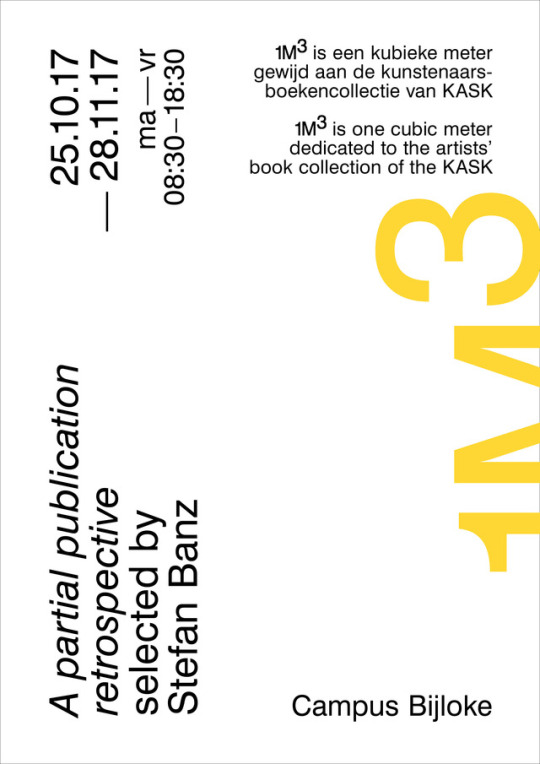
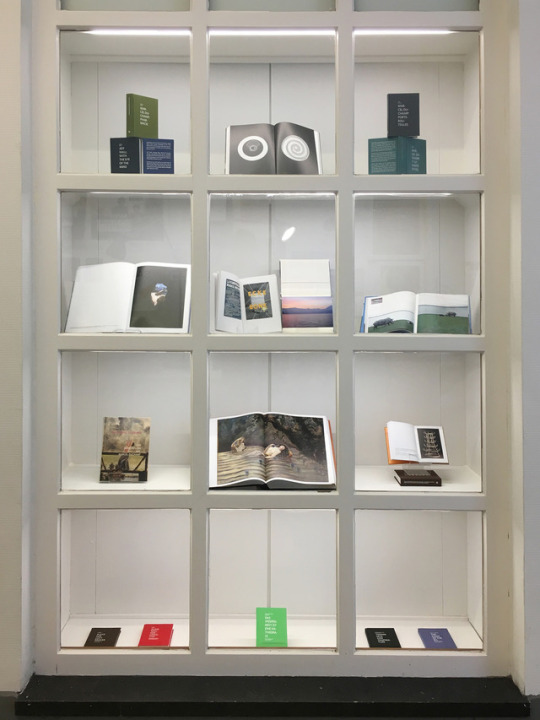
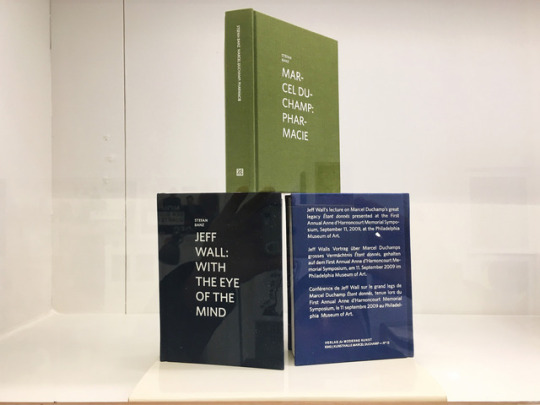
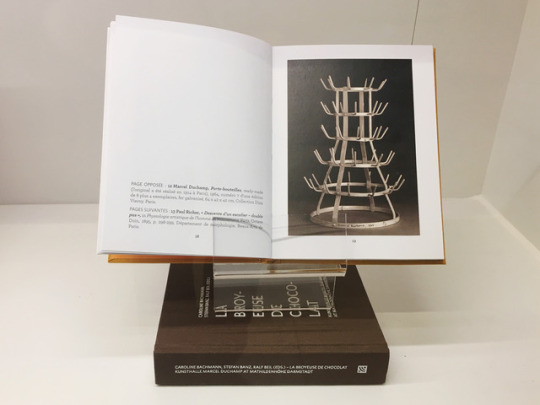
A partial publication retrospective selected by Stefan Banz 25.10.17 – 28.11.17
Top shelf (amongst others):
Banz, Stefan. (2014). Jeff Wall: With the Eye of the Mind. Nürnberg: Edition KMD.
Banz, Stefan. (2013). Marcel Duchamp: Pharmacie. Nürnberg: Edition KMD.
Second shelf from bottom:
Caroline Bachmann, Stefan Banz, Ralf Beil (eds.), La Broyeuse de chocolat. Kunsthalle Marcel Duchamp at Mathildenhöhe Darmstadt. (2013). With texts by Dalia Judovitz, Bradley Bailey, Stefan Banz, Ralf Beil, Martin R. Dean, and Thomas Zaunschirm. Nürnberg: Moderne Kunst.
0 notes
Text
NEWS Beitrag von SEO & Google Marketing - Businesspläne - Finanzierungsvermittlung
New Post has been published on http://www.igg-gmbh.de/zdf-setzt-polit-comedy-eichwald-mdb-fort/
ZDF setzt Polit-Comedy "Eichwald, MdB" fort
}n
n
nnnnnnnnnnnnnnnn
nnnn
nn
Das Team um Hajo Eichwald (Bernhard Schütz, M.), Sebastian Grube (Leon Ullrich, l.), Julia Schleicher (Lucie Heinze, 2.v.l.) und Berndt Engemann (Rainer Reiners, r.), trifft sich im Büro zur Lagebesprechung. Weiterer Text über ots und www.presseportal.de/nr/7840 / Die Verwendung dieses Bildes ist für redaktionelle Zwecke honorarfrei. …n
n n Bild-Infosn n Downloadn
n
n
nn
nnnn n nn n n
Mainz (ots) – Die ZDF-Polit-Comedy \“Eichwald, MdB\“ um den fiktiven Bundestagsabgeordneten Hajo Eichwald wird im ZDF mit einer zweiten Staffel fortgesetzt.
Geplant ist der Dreh der Staffel (6 Folgen à 30 Minuten) für Frühjahr 2018 in unveränderter Besetzung mit Bernhard Schütz als Hajo Eichwald, Lucie Heinze als Julia, Rainer Reiners als Berndt und Leon Ullrich als Sebastian. In den Nebenrollen sind unter anderen wieder Maren Kroymann als Hanke und Robert Schupp als Bornsen zu sehen.
Die Hinterbank lebt! Hans-Josef Eichwald – genannt Hajo – lässt sich auch nach 30 Jahren in der Berufspolitik nicht unterkriegen. Er ist ein politisches Urgestein in turbulenten Zeiten.
Die neuen Folgen setzen drei Jahre nach den Ereignissen der ersten Staffel und in einer neuen Legislaturperiode an. Eichwald, der seinen Bochumer Wahlkreis mit kaum 300 Stimmen Vorsprung gegen einen jungen Rechtspopulisten verteidigen konnte, hat politische Erfolge nötiger denn je. Er sieht sich schon bald mit einem Dopingskandal im deutschen Fußball konfrontiert, der auch politische Konsequenzen hat. Dabei kann Eichwald nach wie vor nicht auf Verstärkung durch sein bewährtes Team bauen, weil das mit Patenschaften für syrische Flüchtlinge, eigenen lokalpolitischen Ambitionen und einer Schwangerschaft schon selbst mehr als genug zu tun hat.
Auf dem langen Weg durch die Institutionen hat Eichwald nicht nur sein gutes Aussehen verloren, sondern auch die meisten seiner Ambitionen. Er ist ein ganz normaler Arbeitnehmer, Ende 50, in der inneren Kündigung – nur dass sein Arbeitgeber das deutsche Volk ist. Bei seiner Abgeordnetentätigkeit wird Hajo Eichwald unterstützt von der jungen, schlagfertigen Büroleiterin Julia, seinem alten Weggefährten und Referenten Berndt sowie dessen mit allen digitalen Wassern gewaschenen Kollegen Sebastian. Auf dem Papier des Grundgesetzes ist Eichwald natürlich nur seinem Gewissen verantwortlich, im Berufsalltag hat dann aber doch meist seine Fraktionschefin Birgit Hanke das Sagen.
Wie schon bei der ersten vierteiligen Staffel ist Stefan Stuckmann Showrunner und Autor. Auch hinter der Kamera setzt das ZDF auf das Team der ersten Staffel: Fabian Möhrke (Regie), Timon Schäppi (Kamera) und Thomas Krause (Schnitt). Produzenten der Kundschafter Filmproduktion sind Dirk Engelhardt, Andreas Banz, Matthias Miegel und Robert Thalheim. Die Redaktion im ZDF liegt bei Daniel Blum.
www.twitter.com/ZDFpresse
Ansprechpartner: Presse-Desk, Telefon: 06131 – 70-12108, [email protected]
Pressekontakt:
ZDF Presse und Information nTelefon: +49-6131-70-12121 n n n n n n
n
0 notes
Photo





Photo 21, 22, 23, 24, and 25
Artist: Stefan Banz
Title: Unknown
Medium: Photography
Source: Science Library
The reason I like Photo 21 (the image of the grown woman licking the bald spot on the old man’s head) is because it’s one of those images that lures you into looking at the rest of a collection of images that a photographer has taken. It grabs your attention. I was looking at Photo 22 with a friend in the library and my friend mentioned how she didn’t like Photo 22 because it was slightly blurry. I told her that the photographer most likely purposely took this image a little out of focus and that that was the exact reason as to why I liked it. One theme that I often saw while looking at Banz’s images was somewhat of a dark/twisted scene in association with an actual child, or a children’s toy.This juxtaposition between something innocent and sinister can also be seen in Photo 23. In this image, it looks like the toy giraffe is being hanged from the door knob. What I like about Photo 24 is the monotony and the dreariness of it. Photo 25 reminded me a lot of Photo 17 by Olivia Bee. Just like I had mentioned for Bee’s image, I like how you can create a story of where this image was taken and of what the story of this image might be (even though you have very little contextual cues).
The one thing I would like to add to my creative sensibility after looking through Banz’s photos is the idea of getting back in the habit of experimenting with a flash. I normally prefer to crank my ISO up instead of using my flash, but Banz has shown me the kind of dramatic images that a flash may help create.
0 notes
Photo

BACK IN THE BOOKSHOP: FRANCIS PICABIA - 1999/2000 & 391 (1999) - First Edition of this comprehensive, beautifully produced Japanese two-volume publication on the life and work of the great French avant-garde painter, poet and typographist, Francis Picabia. Published in 1999 for a Japanese travelling exhibition on Francis Picabia, now long out-of-print. 2 volumes bound in french-fold wraps, beautifully kept fine volumes, both housed in protective corrugated cardboard slip-case with scarlet label. First volume (226 pg.) forms a comprehensive retrospective of Picabia's life and prolific and defying work across painting, drawing, printing, poetry and film. Extensive colour and b&w reproductions of a vast collection of his painting, illustration and publishing projects are presented alongside a folio of his poems and drawings, plus photo documentation of his studio and private/social life. Also includes a biography and bibliography, as well as an insightful conversation between Olga Picabia (Francis Picabia's widow), Pierre Calté (director of Comité Picabia), Hans Ulrich Obrist (independent curator) and Stefan Banz (independent curator), about Picabia's life (text in English and Japanese). Introductory essays in Japanese and French by Beverley Calte and Arnauld Pierre. Second volume (120 pg.) "391" is a very special book made up of collated facsimiles of the 19 issues of Picabia's famous Dada periodical, "391", dating 1917-1924. Despite Picabia's renown as an artist, it was mostly literary in content, with a wide-ranging aggressive tone, possibly influenced by Alfred Jarry and Apollinaire. There were contributions by two men new to Dada: Man Ray and Marcel Duchamp, however 391 remained essentially the expression of the inventive, energetic and wealthy Picabia, who stated of it: "Every page must explode, whether through seriousness, profundity, turbulence, nausea, the new, the eternal, annihilating nonsense, enthusiasm for principles, or the way it is printed. Art must be unaesthetic in the extreme, useless and impossible to justify." - One of the greatest publications on the artist. - One copy via our website and bookshop. - #worldfoodbooks #francispicabia (at WORLD FOOD BOOKS)
1 note
·
View note
Photo
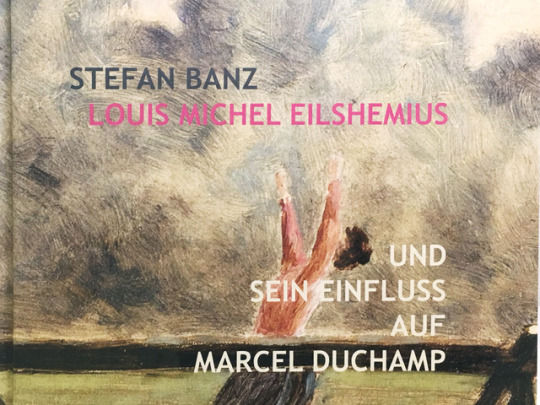
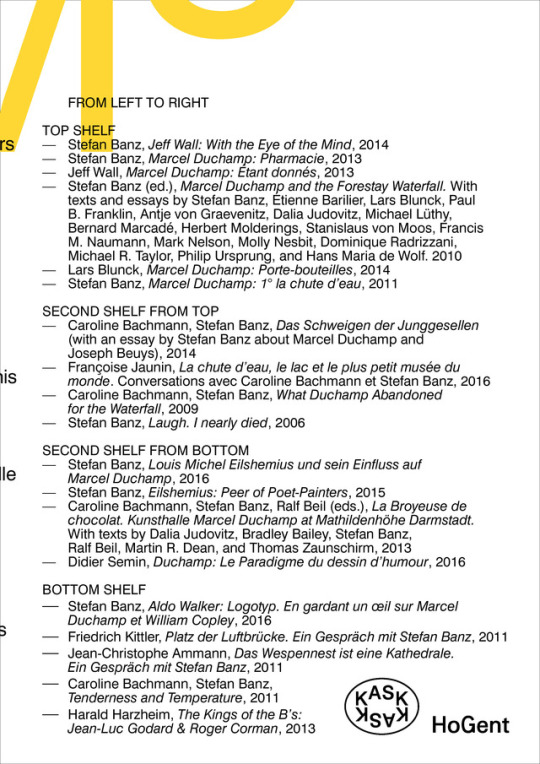
The Swiss artist, author, and curator Stefan Banz has authored and edited a prodigious number of books over the last decade, on contemporary artists, curators and theorists such as Jeff Wall and Friedrich Kittler, as well as historical figures – including most recently Louis Michel Eilshemius, a now largely forgotten painter whom Marcel Duchamp ‘discovered’ in the early 1920s in New York. Duchamp features prominently in Banz’s published oeuvre, particularly the artist’s last work, Étant donnés, the panoramic three-dimensional portrait of a female nude set in a bucolic setting. Banz has firmly established this setting as the area of the Forestay Waterfall, in Switzerland. To mark Duchamp’s attachment to this landscape, Banz and his wife Caroline Bachmann opened in 2009 the world’s “smallest” museum, the KMD–Kunsthalle Marcel Duchamp | The Forestay Museum of Art, in Cully, near Lausanne.
Stefan Banz co-founded in 1989 the first Kunsthalle Luzern and served as its artistic director until 1993. From 1994 to 1997 he was an artistic advisor for the Hauser & Wirth Gallery in Zurich. He curated several major shows internationally and was the curator of the Swiss pavilion in 2005 at the Venice Biennale. As an artist, he has exhibited in various international museums and galleries including the Württembergischer Kunstverein (Stuttgart), the Migros Museum for Gegenwartskunst (Zurich), the Museum Schloss Moyland (the Beuys Museum near Cleves, Germany), and the Walker Art Center (Minneapolis).
With warm thanks to Stefan Banz and CC Strombeek.
0 notes